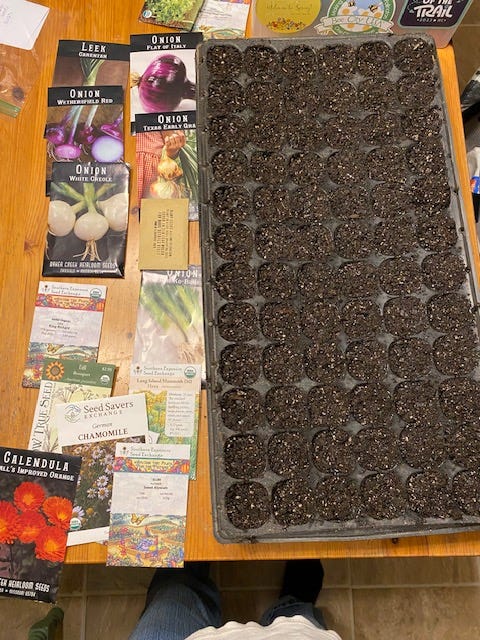I didn’t buy any plants last year, except trees
To quell what I call "garden guilt" I decided to go on strike from buying seedlings.
In an effort to reduce stress during the high growing season, I decided in advance of the season to avoid buying any plants. If you subscribe to this blog (thank you), you can likely empathize with the struggle. Seedlings at farmers’ markets, at nurseries, feed stores, in dreams. They all would have such happy lives if you brought them home. For me, I find those sentiments curdle and turn into guilt. Guilt for not having the time to transplant them, or find the right site. Or, if you do transplant them, you lose time in caring for the many seedlings you started yourself. It’s a tough balance because it’s imbalanced.
My decision to strike plant purchasing was multi-intentional. Yes, I wanted to reduce that garden guilt and stress, but I also wanted to force myself to use what I have, and I wanted any expenses to be investments (read: perennials).
I have grown a huge seed collection, both from saving my own seeds and buying them. When it comes time to start seedlings, I find it hard not to start a few of each variety that I have. What if one seedling fails? I could miss out on those flavors for a whole year before trying again. I have a few dozen varieties of tomatoes. Does that mean I have 100+ seedlings going just to make sure I have 1 of each bear fruit? With all of those seedlings waiting to get potted up or planted out—how could I then buy cute tomato seedlings at the farmers’ market? It’s easy to see how the stress mounts.
How did the year turn out?
Grew from seed. Per usual, I grew my garden from seed. Other than the cost of seedling starting mix, my only other expense was buying seeds that I had run out of. With re-using my seedling trays, the garden only cost me time. I also minimized my potting up efforts by starting seedlings a little later, hardening them off earlier, and transplanting them straight to the garden before rain.
Declined plants. Friends offered seedlings (free plants!) and I turned them away (the horror!)—unless I chose to trade with my own seedlings. That way I knew I wasn’t creating more work for myself and instead just swapping out one-for-one.
Bought perennials. I only bought trees. Three of the apple trees that I planted 4 years ago in my Pittsboro orchard died last winter. I ordered replacement trees from Century Farm Orchards this fall. Fortunately, I got 2 Aunt Rachel apple trees, which is a variety that was created right here in Chatham County. I also ordered other heirloom apple and pear trees and planted an orchard at my mountain apiary. The previous owners of that property had been overzealous with their planting. They added apple and pear trees in random places. All of the trees were vibrant and old enough to bear fruit, but they weren’t close enough together to pollinate. After observing them the past 3 years to see if they would self-pollinate, it was clear they wouldn’t. We removed the existing trees and placed the new trees in closer proximity with each other. For apples, we added: Red June, Yellow June, Old Limbertwig, and Magnum Bonum. We also added Bartlett and Moonglow pear trees.
As I’ve been sharing, I also bought Fraser firs. I planted 150 fir this past fall as part of my permaculture Christmas tree farm experiment.I’ll confess: The only click-baity thing about the title of this post is that I did buy 1 plant—a blackberry bush—and I bought it last week just as the year was coming to an end. Of course, the very next day the shop had a half-off sale and it took a lot of self-control for me not to go back and buy all of the remaining bushes. I prevailed.
In 2025 I’m focusing on:
Succession gardening – sowing and seed starting.
Growing more grains. (I’m making more progress on my seasonal bakery setup.)
Using what I have to create more strategic plant guilds. More on that next time.





